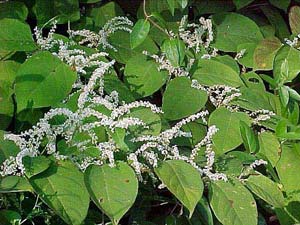Clearwater asks "Help us find Japanese Knotweed" (with pics)
Japanese Knotweed: Invasive Species Assessment
Clearwater Conservancy Riparian Conservation Project

This summer we are surveying Spring Creek for the presence of Japanese Knotweed in order to assess its abundance. Because of its potentially deleterious effect on the watershed, we will use this data to seek funds to treat the problem. Please call or email us if you observe this plant near any waterways (see number/email below).
History
Japanese knotweed, Polygonum cuspidatum, was probably introduced into the United States in the late 1800's from eastern Asia. It was first planted as an ornamental and has also been used for erosion control and landscape screening.
Ecological Threat
It can tolerate a variety of adverse conditions, including deep shade, high temperatures, high salinity and drought. Knotweed is commonly found near water sources, such as along streams and rivers, in low-lying areas, waste places and utility rights-of-way and around old home sites. It spreads quickly to form dense thickets that exclude native vegetation and greatly alter natural ecosystems. Japanese knotweed poses a significant threat to riparian areas, where it can survive severe floods and rapidly colonize scoured shores and islands. Once established, populations are extremely persistent.
Description and Biology
Plant: a member of the buckwheat family (Polygonaceae), knotweed is an upright, shrubby, herbaceous perennial that can grow to over 10 feet in height. Stems of Japanese knotweed are smooth, stout and swollen where the leaf meets the stem..
Leaves: although variable, leaves are normally about 6 inches long by 3 to 4 inches wide, broadly oval to somewhat triangular and pointed at the tip.
Flowers, fruits and seeds: minute greenish-white flowers occur in attractive, branched sprays in summer and are followed soon after by small winged fruits. Seeds are triangular, shiny and very small, about 1/10 inch long.
Spreads: primarily by seed and by vegetative means with the help of long, stout rhizomes. It can be transported to new sites by water, wind, as a contaminant in fill-dirt, or on the soles of shoes. It often escapes from neglected gardens and discarded cuttings.
814-237-0400 [email protected]
Prevention and Control
Japanese knotweed is an extremely difficult plant to control due to its ability to re-grow from vegetative pieces and from seeds. Mechanical and chemical methods are most commonly used to eliminate it. Single young plants can be pulled by hand depending on soil conditions and root development. All roots and runners must be removed to prevent re-sprouting. Glyphosate and triclopyr herbicides have been used, applied either to freshly cut stems or to foliage.
Native Alternatives
sweet pepperbush (Clethra alnifolia) | Virginia sweetspire (Itea virginica) | maleberry (Lyonia ligustrina) |
silky dogwood (Cornus amomum) | fragrant or shining sumac |
|
Taken from publication by USFWS BayScapes Conservation Landscaping Program 7/24/08
http://www.nps.gov/plants/alien/pubs/midatlantic/pocu.htm
- voicesweb's blog
- Login or register to post comments

Japanese Knotweed Pictures
I have a load of pictures on my website in the gallery, if you want any of these please let me know and I can email them to you. I have a lot more on my system if you want anything specific?
Please let me know
Why not post a link to your knotweed gallery?
like the subject line says - lets see the pics.
I know I've seen some knotweed along various roads.